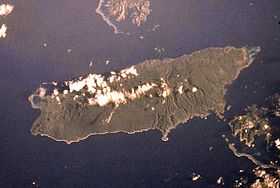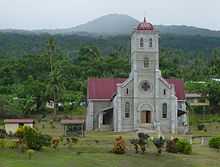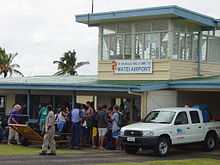Taveuni
| Taveuni | |
|---|---|
 NASA Space Shuttle image of Taveuni. Top of image is NW. | |
| Elevation | 1,241 m (4,072 ft) |
| Prominence | 1,241 m (4,072 ft) |
| Location | |
 Taveuni | |
| Coordinates | 16°49′00″S 179°58′00″E / 16.816667°S 179.966667°ECoordinates: 16°49′00″S 179°58′00″E / 16.816667°S 179.966667°E |
| Geology | |
| Type | Elongated Shield volcano |
| Last eruption | 1550 ± 100 yrs |
Taveuni (pronounced [taβeˈuni]) is the third-largest island in Fiji, after Vanua Levu and Viti Levu, with a total land area of 435 square kilometres (169 Square Miles). The cigar-shaped island, a massive shield volcano which rises from the floor of the Pacific Ocean, is situated 6.5 kilometres to the east of Vanua Levu, across the Somosomo Strait, and is part of Fiji's Northern Division. It had a population of around 9,000, some 75 percent of them indigenous Fijians, at the 1996 census. Taveuni has abundant flora and is known as the 'Garden Island of Fiji'. It is a popular tourist destination.

Geography

The island of Taveuni, about 10.5 kilometres wide and 42 kilometres long, is the top of an elongated shield volcano which erupted from a northeast-southwest trending rift on the ocean floor. About 150 volcanic cones dot the island, including Uluigalau, Fiji's second highest peak at 1,241 meters, and Des Vœux Peak, next in height at 1,195 metres. There have been at least 58 volcanic eruptions since the first human settlement around 950-750 BC, all of which affected the southern two-thirds of the island. Major eruptions from 300–500 AD caused abandonment of the southern areas until about 1100 AD. The latest eruption produced a lava flow at the southern tip of the island around 1550.
Lake Tagimaucia is one of Taveuni's most famous tourist attractions. It occupies a volcanic crater at an altitude of 800 metres, and is the habitat the rare tagimaucia flower. Fiji's most famous waterfalls, the Bouma Falls, are also on the island, located in the Bouma National Heritage Park. As much as 10 metres of rain falls annually on the eastern side of the island, but the western side is sheltered from the southeast trade winds by the ridge that runs the length of the island. South of Vuna village and the lagoon, jet black rocks litter an area known as the South Cape where Taveuni's last volcanic eruption spilled into the sea around 500 years ago. The highlight of the region is the Matamaiqi blowhole with geysers created by trade winds crashing into the volcanic rocks. About 20 minutes by foot from the town of Waiyevo is the Waitavala Waterslide. This entirely natural streambed chute plummets for about 50 metres down the lush hillside and is a favourite haunt for local children and brave tourists.
Many of Taveuni's best known attractions lie underwater though. There are three major, distinct diving areas around the island. To the north of Taveuni lie in close proximity the islands of Qamea and Matagi with their surrounding reef systems. The Rainbow Reef and Vuna Reef are famous for diving and snorkeling, respectively. The Rainbow Reef, on the western side in the narrow Somosomo Strait between Taveuni and Vanua Levu, is known as one of the world's premier soft coral dive areas. The horseshoe-shaped Vuna Lagoon, near the southern end of the island, is much appreciated among divers for the opportunity to see larger pelagic and schooling fish species on the exposed southern side of the reef, whereas the sheltered western parts provide pristine soft and hard coral gardens. There are plans to erect a surfing camp at Lavena Point.
Nearly all plants and animals indigenous to Fiji are found on Taveuni, which has suffered less devastation from land clearance than other areas of Fiji. The absence of the mongoose, a major predator, has also played a part in the survival on Taveuni of land crabs, the unique Fiji fruit bat, the Taveuni Silk bat, and some unique species of palm. Taveuni is also home to the Taveuni Beetle, Orange Dove and the kula parrot, and the Australian magpie, introduced to control coconut pests, has proliferated on the island. To protect Fiji's wildlife, two sanctuaries have been created on the island of Taveuni, namely the Ravilevu Nature Preserve on the east coast, and the Taveuni Forest Preserve in the middle of the island.

Of interesting note is that the island of Taveuni crosses the east-west Antimeridian so the north-eastern portion of the island is located at +179 degrees longitude and the south-western part at -179 degrees longitude. This is often an example that causes havoc to GIS software in which a polygon geometry around the perimeter of the island is incorrectly rendered and wraps around the globe.
Settlements
The population is concentrated mostly on the more sheltered western side of the island. Halfway down the west coast is the administrative centre of Waiyevo. The largest urban area, however, comprises the twin villages of Somosomo and Naqara. As the traditional fiefdom of the Tui Cakau, one of Fiji's highest-ranked chiefs, Somosomo is regarded as the capital of the Tovata Confederacy, while Naqara, an Indo-Fijian settlement, is the island's commercial centre.
History
In 1643, Abel Tasman became the first European to sight Taveuni. Visibility was poor and he mistook the peaks of Taveuni to be separate islands. Historically, Vuna was considered to be the paramount village on Taveuni when the Tui Cakau (Ratu Yavala) resided there, but tribal warfare eventually established the supremacy of Somosomo. In the late 1860s, the Tongan warlord Enele Ma'afu, who had conquered the Lau Islands, was defeated by the Tui Cakau's army in a skirmish at Somosomo. Several islands that sided with Ma'afu were sold by the Tui Cakau at that time to European settlers in punishment, and their inhabitants were moved to Taveuni. The villages of Lovonivonu and Kanacea are populated by their descendants.
In fact, Enele Ma'afu was not defeated by the Tui Cakau's army as stated above. He was in Tonga at that time. In July 1862: Ma’afu went for a visit to Tonga with Tui Bua to seek resolution about his campaign in Fiji with Tongan Parliament. During his absence, Wainiqolo, one of his lieutenant waged war on Golea. Wainiqolo was shot dead on the beach at Wairiki and the Tongans were slaughtered.
Wainiqolo had taken Tui Cakau prisoner when Golea was involved in an internal Cakaudrove campaign. It was an opportune time by Wainiqolo to initiate his campaign whilst Golea was involved in an internal struggle on Vanualevu
Ma’afu never forgave Wainiqolo for the act that he did and removed all land allocated to him. (Historians saw this anger as confirmation that Ma’afu was not part of the Wainiqolo plot to conquer Tui Cakau while he was away in Tonga.)
The unprovoked attack by Wainiqolo was regarded by the Tui Cakau as cancelling his obligation to respect the right of Ma’afu to islands which had been formerly part of Cakaudrove chiefdom. Golea proceeded to resell the whole of Vanuabalavu to Europeans.
On the 3 February 1865: A Court of Arbitration was convened by British Consul Jones who handed down the Court's decision that Ma’afu was the lawful owner of Vanuabalavu and associated islands. Ma’afu immediately executed an affidavit the following day to the effect that Vanuabalavu and all the other lands given to him.
Please read the rest in the "Summary of Key Historical Events" regarding the life of Enele Ma'afu the Tui Lau.
Na Tikina Makawa o Vuna was not defeated by Somosomo as the above statement reads. In fact, historically Taveuni was owned and controlled by two distinct Chieftainship, Tikina o Vuna from the South & one on the North of Taveuni. The Tui Cakau has his land over water opposite Taveuni island and the central part of Taveuni

Economy
Copra has been traditionally the most important crop produced on Taveuni, and has always been the staple of the local economy. In recent times farmers have mainly shifted to growing taro, kava and other speciality crops like vanilla, along with tropical fruit and coffee. During the American Civil War (1861–1865), cotton was raised on Taveuni and exported to Europe. Sugarcane was also grown for a brief period. Livestock such as sheep, cattle and poultry are also raised, but animal husbandry lags behind crop production in economic importance. In recent times, tourism has become a contributor to the local economy, with about a dozen small resorts providing accommodation options for visitors and employment and business opportunities to the local population.

Language
The Taveuni dialect of Fijian reflects Tongan influence. One of its most distinctive features is the replacement of the consonant 'k' by a glottal stop. The Tui Cakau is therefore known locally as the Tui Ca'au.
Notable Taveunians
Perhaps the best-known Taveuni resident internationally was Ratu Sir Penaia Ganilau (1918–1993), Fiji's last Governor-General and first President, who was also Tui Cakau. The Ganilau family is a branch of the Ai Sokula clan, to which the present Tui Cakau and Cabinet Minister Ratu Naiqama Lalabalavu also belongs. Another notable Taveunian is Fiji's current First Lady, Adi Salaseini Kavunono, wife of President Ratu Josefa Iloilo.Ratu Jone Yavala Kubuabola is Fiji's Minister for Finance, a position he has held since 2000. He also represents the South West Urban Fijian Communal constituencies in the House of Representatives, to which he was elected as a candidate of the Soqosoqo Duavata ni Lewenivanua (SDL) in 2001. He was also a former Governor of the Reserve Bank of Fiji. Ratu Inoke Kubuabola (younger brother of Ratu Jone Yavala Kubuabola) is a Fijian politician who served as Leader of the Opposition in 1999 and 2000. He became leader of the Fijian Political Party (Soqosoqo ni Vakavulewa ni Taukei, or SVT) following its defeat in the 1999 election and the subsequent resignation of its leader, the defeated Prime Minister Sitiveni Rabuka, from Parliament.Kubuabola served as Fiji's High Commissioner to Papua New Guinea from 2002 to 2005. In late 2005, he attempted to handle the problem of Fijian security guards, whom some accused of being mercenaries, operating illegally on the island of Bougainville. The incident embarrassed the Fijian government and threatened to strain relations between the two countries.
On 4 May 2006 Kubuabola was posted to Tokyo as Fiji's Ambassador to Japan and Korea, replacing Ratu Tevita Momoedonu. He remained in this position until July 2009; on 24 July, he was named Minister for Foreign Affairs by the Interim Government.The Kubuabola family is a branch of the Ai Sokula clan, to which the present Tui Cakau and Cabinet Minister Ratu Naiqama Lalabalavu also belongs.
See also
References
- Global Volcanism Program: Taveuni. Smithsonian Institution - Worldwide Holocene Volcano and Eruption.
| |||||||||||
| |||||